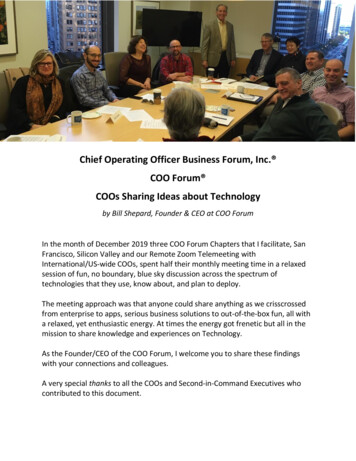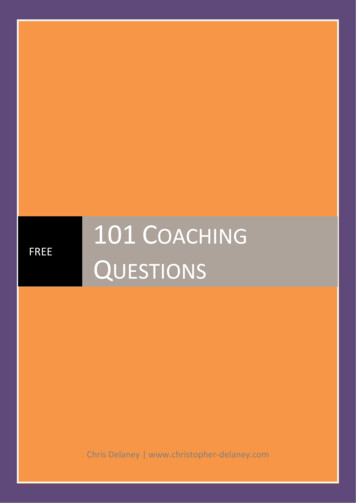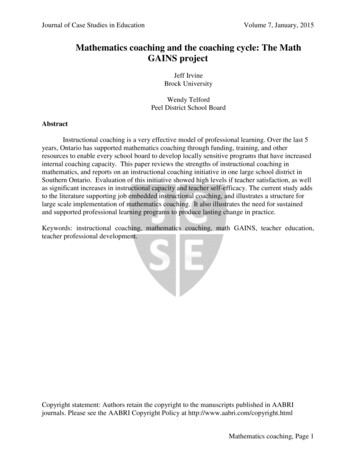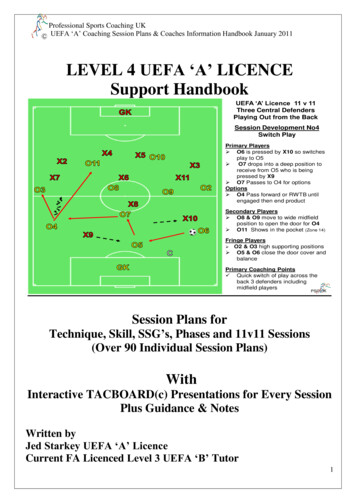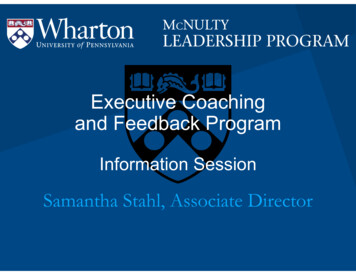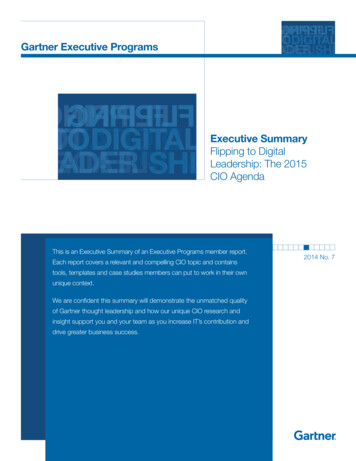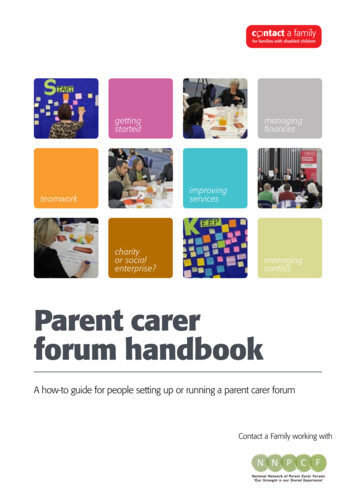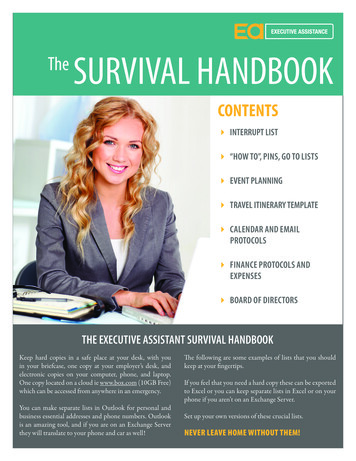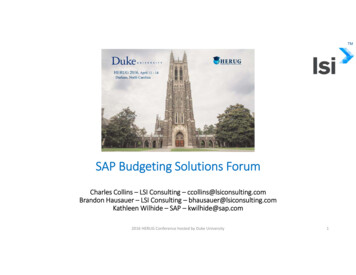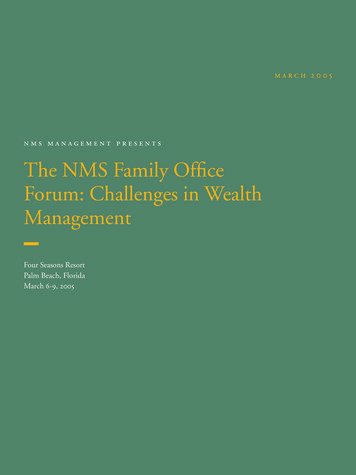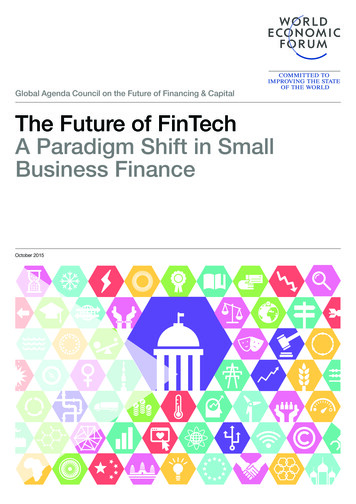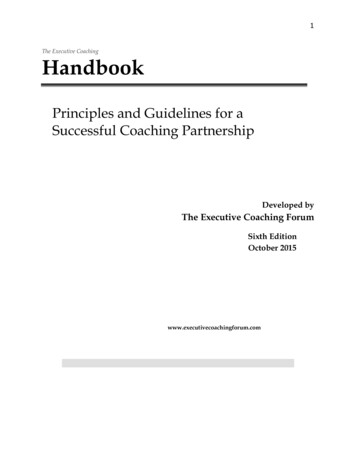
Transcription
1The Executive CoachingHandbookPrinciples and Guidelines for aSuccessful Coaching PartnershipDeveloped byThe Executive Coaching ForumSixth EditionOctober 2015www.executivecoachingforum.com
2Copyright 2001-2015 by The Executive Coaching ForumAll Rights ReservedThis Handbook may be reproduced only for the benefit of people involved withexecutive coaching (executives, coaches, HR professionals supporting a coachingproject, managers and other colleagues of an executive being coached), and only whereno fee will be charged nor profit made as a result of the reproduction or distribution ofthe Handbook.The following notice must be printed in place of the above copyright statement whenany changes are made to the Handbook:The original version of this Handbook was developed and copyrighted by TheExecutive Coaching Forum (TECF). It has been revised significantly from itsoriginal form by (name of person(s)/entity) in the following ways: (describerevisions). TECF endorses the original version of the Handbook only. Therevisions are supported by, and are the responsibility of, those people/entities thathave made them.Contributors to this HandbookThe Sixth Edition 2015 was edited by Susan Ennis and Judy Otto. Along with Judyand Susan, Robert Goodman, Bill Hodgetts, James Hunt Richard Mansfield and LewStern co-authored the Core Competencies of the Executive Coach 2005. All writing andediting efforts on the Executive Coaching Guide have been a volunteer effort.Original drafters of Handbook were Susan Ennis, Judy Otto, Lewis Stern, Michele Vitti,and Nancy Yahanda. Other Human Resource and Management Consultingprofessionals from leading organizations in the Greater Boston business communityalso provided input to the first edition. They include Betty Bailey, Wendy Capland,William Hodgetts, Mary Jane Knudson, Kitti Lawrence, Lynne Richer, Casey Strumpf,and Ellen Wingard. Larissa Hordynsky and Lew Stern edited the original version of thisHandbook. Michael Madera worked on the website and on-line versions.Additional feedback for subsequent editions has come from executive coachingprofessionals from all across the United States, and the world including Canada, GreatBritain, Brazil, South Africa, Chile and others.
3The Executive Coaching HandbookTable of ContentsThe Need for a Handbook .Handbook Organization .Defining Executive Coaching.What Is Executive Coaching?.What Is a Coaching Partnership?.What Is Different About Executive Coaching?.Overarching Principles for Executive Coaching .1. Systems Perspective.2. Results Orientation .3. Business Focus.4. Partnership.5. Competence .6. Integrity .7. Judgment.Guidelines for Practice .1. Managing Confidentiality.2. Pre-coaching Activities.3. Contracting .4. Assessment.5. Goal Setting.6. Coaching.7. Transitioning to Long-Term Development .Core Competencies of the Executive Coach.Why a Competency Model?.Defining Executive Coaching.Psychological Knowledge.Business Acumen.Organizational Knowledge.Coaching Knowledge.Coaching Tasks and Skills.Building and Maintaining Coaching Relationships.Contracting.Assessment.Development Planning.Facilitating Development and Change.Ending Formal Coaching & Transitioning to long-term development.Attributes and Abilities.Mature 41434648484850515253525556575859616262
4Positive Energy.Assertiveness.Interpersonal Sensitivity.Openness and Flexibility.Goal Orientation.Partnering and Influence.Continuous Learning and Development.Integrity.6364656667686970
5The Need for a HandbookThe History and Future of the Handbook and Competency ModelExecutive Coaching has become commonplace in leadership development in the U.S.and internationally. It is seen as a viable lever in developing high potentials, retainingtop talent, readying executives for more demanding roles, and building a leadershippipeline. Organizations that use coaching report that they’ll likely increase its use in thecoming years.Executive coaching continues to grow in popularity and prestige. In the past 20 years,significant progress has taken place in clarifying definitions and practice guidelines, yetthere is still no widely agreed upon definition or set of professional standards. In 1999,when a group of Boston area executive coaches, leadership development consultants,and human resources professionals began meeting regularly to put guidelines in placefor our own practices and organizations, we realized that we were creating a valuableresource for the field and a way to jump start the conversation about professionalstandards.In 2000, we became the Executive Coaching Forum and published the First Edition ofThe Executive Coaching Handbook: Principles and Guidelines for a Successful CoachingPartnership. This Handbook was conceived as starting a dialogue in the field about whatexecutive coaching is, when and how to use it effectively and ethically, and how tomeasure its efficacy. Next, we realized that there are many approaches to training forexecutive coaches but no agreed upon set of qualifications.In 2005, we added the Competency Model to help define the knowledge areas, tasksand skills sets, attributes, and abilities that are critical for executive coaches to developand exhibit in order to create effective experiences for clients. Research into the field ofExecutive Coaching has been significantly improved by the entrance of the Institute forCoaching at McLean/Harvard Medical School www.instituteofcoaching.org.The mission of the Institute is to build the scientific foundation and best practices ofleadership, wellness, and personal coaching. In the field of executive coaching, theInstitute is a leader in driving and supporting research in best practices. Because weknow the Institute will carry on the tradition of raising key questions for the field andproviding a place to discuss them with old and new audiences, in the autumn of 2015we published the 6th Edition of the Handbook and handed it off to the Institute forfuture distribution. We hope this 6th edition continues and expands this dialogue.We wrote The Executive Coaching Handbook as a service, with the explicit intent to get theHandbook out to a broad array of users and practitioners to promote interest andprogress in creating a well-respected profession. We have distributed the Handbook at
6www.executivecoachingforum.com as an open source document, free of charge,requesting only that you send us notification if you use it, and that you don’t charge forour work if you share it with others. The Handbook is used in hundreds of executivecoach training programs and by tens of thousands of coaches in more than 40 countries.The Guide will be available atwww.theexecutivecoachingforum.com until 2017.It is also now available at www.instituteofcoaching.org.
7Handbook OrganizationThe Executive Coaching Handbook is divided into four sections as follows:Defining Executive Coaching describes executive coaching and the partnershiprequired for maximum success. We believe executive coaching is most successful as athree-way partnership among coach, executive, and the executive’s organization. Eachpartner has an obligation and responsibility to contribute to the success of the coachingprocess. Although the primary work is between executive and coach, coaching isalways an organizational intervention and, as such, should be conducted within thecontext of the organization’s goals and objectives.Overarching Principles for Executive Coaching describes a set of values or goals thatguide the coaching process. These principles provide a compass that the coach, theexecutive, and other members of the organization will use to set, maintain, and correcttheir course of action.Guidelines for Practice provide procedural help for all coaching partners. Theseguidelines define the components of the process and outline the commitments that eachpartner must make.Core Competencies of the Executive Coach lists a robust set of four knowledge areasfundamental to the work of executive coaching: psychological, business, organizationaland coaching competencies; the tasks and skills sets aligned to the six phases of thecoaching process; and the 10 attributes and abilities that promote superior performance.Each of these competency areas is separated into basic and advanced levels.
8Defining Executive CoachingWhat Is Executive Coaching?Executive coaching is a developing field. As such, its definition is still the subject ofdiscussion and debate among practitioners, researchers, and consumers. Executivecoaching involves an executive, his coach, and his organizational context (asrepresented by the interests of his organization and supervisor, including the fact thatthe organization typically pays for coaching services). All are key stakeholders in theprocess. This fact by itself would appear to differentiate executive coaching from otherinterventions, such as career counseling and life coaching.While both career counseling and life coaching can lend concepts and practicetechniques that an executive coach might use, they focus solely on the individual clientand his needs and goals. Executive coaching, in our view, focuses on the needs andgoals of both the executive and the sponsoring organization. In that spirit, we offer thefollowing definition of executive coaching.Executive coaching is a one-on-one individualized process to benefit the leader andhis/her organization. Working with goals defined by both the leader and theorganization, a qualified and trusted coach uses various coaching methods andfeedback data to develop the leader’s capacity for current and future leadership. Thiscoaching is guided by a coaching partnership to achieve maximum impact and thehighest level of learning.Definition of TermsIndividualized. The goals and specific activities are tailored to the unique aspects of theindividual(s) and the organizational system.Leader: We use the term broadly to mean any individual(s) who have the potential ofmaking a significant contribution to the mission and purpose of the organization.
9One-on-one: The primary coaching activities take place between the individualleader(s) and the coach.Develop capacity: Developing new ways of thinking, feeling, acting, learning, leading,and relating to others builds individual and organizational effectiveness.Feedback data: In order for the executive and her principal stakeholders to understand,clarify, and commit to appropriate coaching goals, various data collection methods areused to identify key factors and skills required in the organizational context. Theappropriate use of interviews and standardized instruments assures accuracy andvalidity of data gathered from people representing a range of perspectives within theorganization.Qualified coach: Since there is no official licensing of executive coaches, it is importantthat the organization and executive are protected by knowing what competencies arerequired at basic and advanced levels for the coaching to be successful.Trusted coach: A coach earns trust with an executive and an organization by the use ofethical practices and confidentiality. The coach maintains equal status with theexecutive so as to advise and guide outside of hierarchical constraints.Coaching Partnership?The coaching partnership is a win-win systems approach in which all partners in theeffort plan the process together, communicate openly, and work cooperatively towardthe ultimate accomplishment of overarching organizational objectives.1. The executives, the coach, and other key stakeholders in the organization collaborateto create a partnership to ensure that the executive’s learning advances theorganization’s needs and critical business mandates.The executive coach can be either external to the organization or an employee of theorganization.
102. The partnership agrees on ground rules, time frames, and specific goals andmeasures of success.3. The coaching partnership uses agreed-upon approaches, including: creation of a development plan skill building performance improvement development for future assignments exploration, definition, and implementation of the executive’s leadership and theorganization’s business objectives.(From Robert Witherspoon and Randall P. White, Four Essential Ways that Coaching Can HelpExecutives, Center for Creative Leadership, 1997.)4. The ideal coaching process includes: pre-coaching needs analysis and planning contracting data gathering goal setting and development of coaching plan implementation of coaching plan measuring and reporting results transitioning to long-term development.5. The coach may use the following practices, among others: problem solving and planning rehearsal (role play) and on-the-job practice feedback dialogue clarification of roles, assumptions, and priorities teaching and applying a variety of management and leadership tools referral to other developmental resources.6. The focus of the partnership is on enhancing the executive’s strengths and buildingthe key competencies needed to achieve strategic business objectives.
117. The partnership involves key stakeholders in the coaching process (called “otherpartners”), including: the executive’s manager senior management Human Resources and related in-house groups, such as OrganizationalDevelopment or Organizational Effectiveness, peers, including strategic business partners from other organizations direct reports other key people in the executive’s life.8. Executive coaching is typically paid for by the organization that employs theexecutive.9. A successful coaching partnership is guided by ethical guidelines, and provenpractices that maintain the welfare of the executive and her coworkers.Three Levels of LearningExecutive coaching involves three levels of learning:1. Tactical problem solving2. Developing leadership capabilities and new ways of thinking and acting thatgeneralize to other situations and roles3. “Learning how to learn”: developing skills and habits of self-reflection thatensure that learning will continue after coaching endsThe third level is an important and sometimes overlooked goal of coaching. Its aims areto prevent an executive's long-term dependency on his coach and teach habits oflearning and self-reflection that will last a lifetime, enabling him to keep developingthroughout his career.What Is Different About Executive Coaching?As all forms of coaching have grown in popularity over the past few years, it isimportant to differentiate and define the various forms so that leaders andorganizations are aware of what is being purchased and delivered. As all forms ofleadership coaching have moved into the mainstream of business, government and non-
12profits, it has become more of a commodity, making it harder to distinguish betweenthe different forms of coaching being offered and then sorting out what is form is mosteffective for the issues presented by the leader and the organization.The practice of executive coaching may involve many of the coaching approaches andtactics described below. Thus over time, an executive coaching engagement may touchon many aspects of the executive's performance, leadership style, career or personal lifeissues.However, two factors always distinguish executive coaching from these other types:1. To be most effective systemically, it always involves a partnership among executive,coach, and organization.2. The individual goals of an executive coaching engagement must always link back toand support strategic organizational objectives.A discussion of some common coaching types follows.Career CoachingThe career coach helps individuals identify what they want and need from their career,then make decisions and take the needed actions to accomplish their career objectives inbalance with the other parts of their lives.Group CoachingGroup coaches work with individuals in groups. The focus can range from leadershipdevelopment to career development, stress management to team building. Groupcoaching combines the benefits of individual coaching with the resources of groups.Individuals learn from each other and the interactions that take place within the groupsetting. Often the coach observes the group interacting at work or in meetings and thenfeeds back to the group the dynamics and behaviors that are helping or hindering theteam.Peer Coaching
13In this form of coaching a group of peers are trained to explore work issues with eachother using the group to ask compelling questions, provide feedback and occasionallyadvice. The peer group is a stable and committed group. Sometimes a coach facilitatesthe group.Performance CoachingPerformance coaches help employees at all levels better understand the requirements oftheir jobs, the competencies needed to fulfill those requirements, any gaps in theircurrent performance, and opportunities to improve performance. Coaches then workwith the employees, their bosses, and others in their workplace to help the employeesfill performance gaps and develop plans for further professional development.New Leader/Onboarding or Transition CoachingCoaches of individuals assigned or hired into new leadership roles help these leadersaccelerate their assimilation into and effectiveness in the new position. The goal of thecoaching is to clarify with the leader’s key constituents the most importantresponsibilities of her new role, her deliverables in the first few months of the newassignment, and ways in which she and her team are interdependent with others in theorganization.High-Potential or Developmental CoachingThe coach works with organizations to develop the potential of individuals who havebeen identified as key to the organization’s future or are part of the organization’ssuccession plan. The focus of the coaching may include assessment, competencydevelopment, or assistance planning and implementing strategic projects.Coaching for 360 Debriefing and Development PlanningOrganizations that use assessment or 360 feedback processes often utilize coaches tohelp employees interpret the results of their assessments and feedback. In addition,
14coaches work with individuals to establish professional development plans based onfeedback, assessment results, and other relevant data.Targeted Behavioral CoachingCoaches who provide targeted behavioral coaching help individuals to change specificbehaviors or habits or learn new, more effective ways to work and interact with others.This type of coaching often helps individuals who are otherwise very valuable to theirorganizations modify or change a behavior that is counterproductive.Legacy CoachingThe legacy coach helps leaders who are retiring from a key role to decide on the legacythey would like to leave behind. The coach also provides counsel on transitioning out ofthe leadership role.Succession CoachingThe succession coach helps assess candidates for senior management positions andprepares them for promotion to more senior roles. Such a coach must have specificassessment technology skills. If not, the assessment and coaching would be providedby different people.Although this type of coaching may be used in any organization that is experiencinggrowth or turnover in its leadership ranks, it is essential in family businesses in order tomaintain the viability of the firmPresentation/Communication Skills CoachingThis type of coaching helps individuals gain self-awareness about how they areperceived by others and why they are perceived in that way. Clients learn new ways tointeract with others. The use of video recording with feedback allows clients to seethemselves as others do. The coach may help clients change the way they communicate
15and influence others by using a different vocabulary, tonality, and/or body language toconvey their intended messages.Team CoachingOne or more team coaches work with the leader and members of a team to establishtheir team mission, vision, strategy, and rules of engagement with one another. Theteam leader and members may be coached individually to build skills in facilitatingteam meetings and other interactions, build the effectiveness of the group as a highperformance team, and achieve team goals.Personal/Life CoachingThe personal/life coach helps individuals gain awareness of and clarify their personalgoals and priorities, better understand their thoughts, feelings, and options, and takeappropriate actions to change their lives, accomplish their goals, and feel more fulfilled.This form of coaching may be integrated into an Executive Coaching engagement butonly as part of a strategy approved by the organization.Health CoachingThis is a fast growing form of coaching being used by insurance companies, healthcenters and organizations to ensure the well-being of individuals. It can beincorporated into am Executive Coaching engagement.
16Overarching Principles for Executive CoachingOverarching principles are the values that guide the coaching process. These principlesprovide a compass that the coach, the executive, and other members of the executive’sorganization will use to set, maintain, and correct their course of action.1. Systems PerspectiveExecutive coaching is one of many approaches or types of interventions that can beused to promote organizational and leadership development. The goal ofdeveloping a single leader must always be pursued within the larger objective oforganizational success. Since executive coaching should be conducted as one of thecomponents of an overall plan for organizational development, executive and coachmust both be aware of the larger organizational objectives.Piecemeal executive coaching activities do not have the impact of full executivecoaching unless they are conducted as part of the process described underGuidelines for Practice in this Handbook.The coach must have expertise in organizational dynamics and businessmanagement in order to conduct the coaching with awareness and understanding ofthe systems issues. Approaching executive coaching from a systems perspectiverequires the coach to recognize and appreciate the complex organizational dynamicsin which the executive operates. The coach ensures a systemic approach throughcontinual awareness of the impact of the coaching process on everyone in the systemand vice versa. Accordingly, the coach encourages a shift in the executive’sviewpoint, from seeing himself as separate to recognizing his interdependence withother people and processes in the organization. This approach encourages respectfor the complexity of organizational life and an ability to penetrate beyond this
17complexity to the underlying structures. In effect, the coach helps the executive tosee both “the forest and the trees”.Coaching from a systems perspective enables both the coach and the executiveassess development needs. Systems thinking also encourages all partners toappreciate the impact of the executive’s behavioral change on other facets of theorganization.Executive’s Commitments Explore changes in your own vision, values, and behaviors. Examine how your own behaviors and actions affect the systems in which youoperate. Work in open exploration with your coach; help your coach to understand theforces of the organizational system. During the coaching process, take responsibility for your actions and remainaware of the impact of your behavioral changes on others and the organizationas a whole.Coach’s Commitments See the executive, his position, and the organization through multiple lenses andperspectives. Maintain an objective and impartial perspective by resisting collusion with theexecutive or the organization. Recognize and appreciate the complexity of the organizational structure in whichthe executive functions. Encourage the executive to explore both long- and short-term views. Recognize the interaction of all parts in the whole, especially how change in oneof the executive’s behaviors may affect other behaviors and other people. Help the executive distinguish between high- and low-leverage changes.Encourage commitment to the highest-leverage actions to achieve results.
18Other Partners’ Commitments Identify and share organizational information that may help the coach and theexecutive recognize and understand the context, organizational forces, businessrelated issues, and financial constraints they must factor into the coaching. Guide the coach regarding organizational changes that may influence thecoaching. Be willing to examine and possibly change aspects of the organizational systemin order to improve both the executive’s and the organization’s performance.
192. Results OrientationExecutive coaching is planned and executed with a focus on specific, desired results.The executive, her coach, and the organization begin by deciding on the goals of thecoaching. Key members of the coaching partnership sign off on a written coachingplan that specifies expected deadlines for accomplishing each goal. Appropriatemeasurements are applied to each goal, including follow-up and feedback reports.Specific activities, during the coaching sessions and in between, focus specifically onachieving the agreed-upon goals for the executive and her organization.Executive’s Commitments Take responsibility for focusing the coaching on the results you care about most. Commit adequate time between coaching sessions to work on the results. Prepare well for each coaching session. Monitor your own results and communicate with coaching stakeholders aboutyour accomplishments and the gaps that still exist. Enlist support to attain results.Coach’s Commitments Push the executive and her organization to be specific about desiredaccomplishments and how results will be measured. Structure each coaching session with a results-driven agenda, following up onprevious meetings and the actions taken between sessions. Facilitate communication between the executive and the organization about whatthe executive is working on, her progress, and her support needs. Plan follow-up meetings to track progress toward coaching goals. Drive thesemeetings even in the face of the organization’s work
interventions, such as career counseling and life coaching. While both career counseling and life coaching can lend concepts and practice techniques that an executive coach might use, they focus solely on the individual client and his needs and goals. Executive
